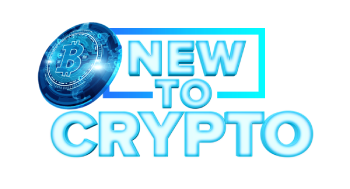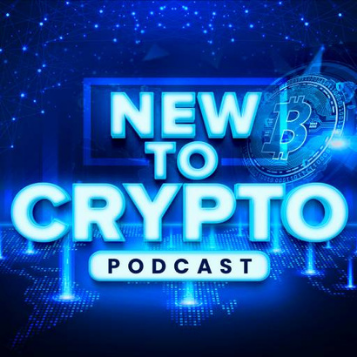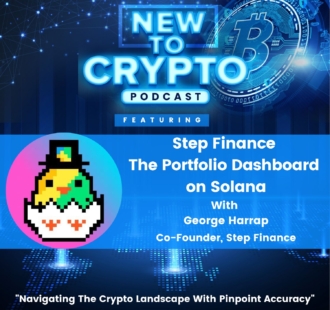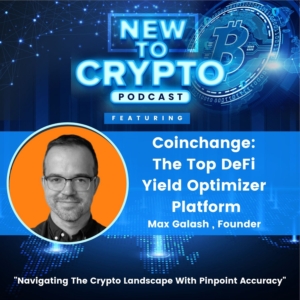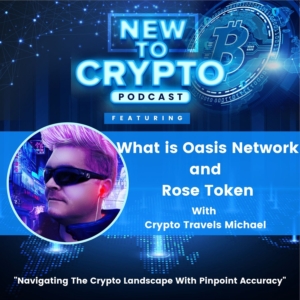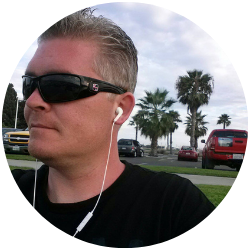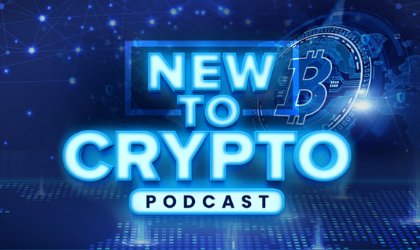Step Finance Interview
SUMMARY KEYWORDS
Solana, crypto, people, blockchain, build, wallet, step finance, ecosystem, token, product, defy, nft, game, protocols, listeners, hackathon, projects, coins, started, insights
SPEAKERS
George Harrap, Crypto Travels Michael
Michael 00:00
Welcome to the New To Crypto Podcast designed to guide you through the crypto landscape with pinpoint accuracy created for the new and intermediate crypto investor. Join your host Crypto Travels Michael as he takes you through the different facets of getting started and succeeding in your crypto journey. New To Crypto Podcast brings you new episodes daily Monday through Friday with surprise bonus episodes sometimes on the weekend. Let me ask you, Are you new to crypto and don’t know where to start? Are you more experienced but have questions? Then you’re in the right place. This podcast is designed for you coming at you from the training center in the lifestyle design studio. Here’s your host Crypto Travels Michael. Hey, welcome to today’s podcast. I’m excited about today’s show. I have a phenomenal founder on the show for you today. He’s actually the founder of step finance, which is the front page of Solana everyone. It’s the largest portfolio dashboard on Solana and today’s guest has been in the crypto space for over a decade, having previously been a miner and a trader and built six exchanges. He was the founder of the world’s first crypto remittance startup bit spark. And recently, George has been focusing on the defy space to further the banker’s future. Please welcome George Hara to the show. George man. It’s a pleasure to have you here. Welcome to the show.
George Harrap 01:34
It’s a pleasure to be here. Thank you very much for having me on.
Michael 01:38
Absolutely. Live in Istanbul today. Huh?
George Harrap 01:41
The place to be man. A lot of crypto stuff going on here. It’s a cool city.
Michael 01:45
Awesome. We have listeners in Turkey. Hey, can you share just a little bit about yourself with our listeners before we dive in?
George Harrap 01:53
Sure. Yeah. So I’m George. I’ve been in crypto for, I don’t know, 11 or 12 years now. Started off originally as one of the early Bitcoin miners I guess. Sort of I was 1% of the network back then. building stuff in my own room and building a heater that made money which was a bitcoin miner, which is the best kind of heater. And yeah, ever since then, you mentioned one of the first startups I helped co-found was bitsbox Crypto remittances. So I lived in Hong Kong for about six years. And that was all about using crypto to send money around the world. And my second venture step sort of came out of a lot of the defi summer. sort of you know what happened there, right? Like we had a lot of these different protocols popping up. We had essentially financial applications on a blockchain rather than just like, hey, I can send you money. It’s like now oh, by the way, you can get a loan, you can have exchanges themselves, like on the blockchain, you don’t have to trust anyone with the funds. So I thought building a financial system is probably the next logical step for crypto. And yeah, we started step with a couple of buddies of mine back in, was it 2021? Now it sounds like a long time ago, but it wasn’t really. And yeah, we sort of were one of the original sorts of ones, protocols that grew up on Solana. So we’re essentially a portfolio dashboard. And we’re a place that keeps track of all of your different investments wherever they might be, whether you got yield farms and FTS lending protocols. We integrate with literally everyone and put all the information in one space. And we’re all about data. So we want to be able to show you those data insights and tell you what’s happening in your portfolio. So yeah, that’s sort of the speed run of everything that’s happened in the last decade.
Michael 03:36
Exciting. We’ll actually have some questions about Step. And if you could just share with our listeners, just an overview, you kind of touched on what step is, and, and also, you know, why was it built on Solana and when you go to your website, you know, it says the front page of Solana. So can you paint a picture for our listeners around the world? Just a little bit more about what that means.
George Harrap 03:57
Absolutely. Yeah. So the front page of Solana sort of tagline that we came up with, I think is pretty relevant. Because essentially, when someone goes to a new blockchain, they’re kind of expecting a couple of things to exist in terms of like an active, vibrant ecosystem. You want DEX’s to exist. So you want to be able to swap coins. You want to be able to NFTs, NFT marketplaces, liquidity, active projects, these sorts of things, lenders, there has to be like the ability to borrow against different coins or whatever it might be. Maybe it’s yield farms as well. Maybe liquid staking might be something that people are interested in. So and then there are more complex financial products, there’s options and futures and blah, blah, blah. I think these are the kind of building blocks that any sort of blockchain ecosystem that’s trying, to be an alternate alternative financial system really has to have, and really there are only a couple of blockchains that really have all of those ingredients. Solana is one of them. But a year ago, Solana was was kind of a nothing It started essentially, as a value proposition was, hey, we’re really fast, and really low cost for doing swaps and transactions. But really what you need to grow an ecosystem is liquidity. And when we were looking around, we essentially were looking for a couple of buddies of mind to building a DCAA platform, a place where you can put some money in and maybe buy a coin once a day, or once every week, or something like that in an automated way. And we had a look around. And obviously, we tried a theory and built out a contract there. Some of the L TOS didn’t really exist, or they’re in their infancy.
But it was quite expensive to do any transactions there. And the breakeven in terms of the number of users you would need to pay for their gas costs was super high. But at the time, Solana was just getting started. And there were a couple of hackathons going on in Solana. So we thought, hey, let’s check this new thing out. Let’s see what it’s all about. And really all of the different coins from across the ecosystem, including the Ethereum ecosystem, and elsewhere, were already wrapped. And there was already liquidity on Solana for people to transact with. So we thought, hey, let’s check it out. We entered a hackathon. And essentially, that’s sort of the genesis of step is we built out a product that could be this, as you say, the front page of Savannah, but it’s really a dashboard to keep track of all of the different stuff, which is happening in your wallet. And your wallet might be doing like 20 different things, right? You don’t want to have 20 different tabs open. So put it all on Step Put all in one place. But for us, it means that we need to integrate with everyone we need to deal with the intricacies of all these different weird contracts. Some are standardized, some are not some are custom things. Some are, you know, terrible to deal with. Some are much easier to deal with. So yeah, that’s kind of a lot of what we started was trying to stitch that all together and put it all in one place.
Michael 06:47
Fantastic. Would you say that some of the points you just covered are basically the reasons why Solana is different than other layer ones, or what else would you add to that?
George Harrap 06:57
Yeah, I think for layer one to be successful. Suddenly, right now, we’re seeing a lot more active users experimenting with our ones. In fact, that’s probably where all of the active users are, to be honest. They’re all on things like Solana BSE. Ethereum, yes, but not as much as perhaps others. And there are a couple of L TOS going around. But they haven’t really got critical mass. So as far as I’m concerned, there are probably maybe two maybe three games in town in terms of having an active ecosystem that has everything. But yeah, I think what people want is fast transactions, low-cost transactions, and need to have an active ecosystem in which you can build blocks on top of each other, right? Like, if there are no liquidity pools, or no ATMs, or no taxes, then well, you can’t really swap coins and no one wants to launch their project on there. And you know, they’re going to look somewhere else. So they’re kind of it’s like a chicken in an egg. And I think Solana was able to solve that early on, with people like Alameda, the world’s largest market, making fun they were market making on Solana that certainly helped a lot of that early sort of coins that had liquidity because of them. So that sort of provided the base, and then it sort of grew from there. But now it’s kind of got this critical mass where the last hackathon there was something like 8000 entrants, there were 505 100 different submissions of different people building stuff, they have these hackathons every couple of months, as well. So like, when we’re talking about numbers, like these are huge numbers, you know, 500 different projects that people have built during a couple of weeks hackathon. That’s amazing. Also daunting for us, right? Because if that’s happening, we have to integrate 500 new things tomorrow. Yeah, you know, so, but that’s okay. Have a strong cup of coffee during
Michael 08:41
that exam.
George Harrap 08:42
Exactly. But these are healthy things, right? Like you want to see, you want to see developers building stuff. So and there’s also like, you know, what comes first developers or users? You know, the users are gonna go somewhere, and then everyone’s gonna be like, oh, man, we really need to go and build things because everyone’s over there. Or you’re going to build things first. And then everyone comes in. I would say, it’s probably the latter. You certainly do need to build something for people to go there. So yeah, look, I think salon has been able to foster a lot of that developer support and lots of different documentation and guides and different ways to go and build stuff. And that helps grow the ecosystem and gets people excited about it. So yeah.
Michael 09:23
Okay, excellent. Thanks for unpacking that. So can you share with our listeners, like can you talk to us about plans for maybe bringing the Masters you touched on that into Solana since I mean, your step is essentially the dashboard for Solana, you know, and yeah, yeah, if you could share a little more about the dashboard as well. For our listeners who may not even be familiar with Solana, maybe they’ve just got started in crypto.
George Harrap 09:48
Absolutely. Yeah. So we started off, focusing more on defy so defy decentralized finance applications. I mentioned a couple of different sorts of things before, mainly focused on the financial products It’s really so the yield farms, the products of the future, the options trading, you know, whatever it else it might be Dexter’s AM’s LPS yield farms, these are all words which might make sense to people that are familiar with defy, but essentially they’re all financial things right and that’s that’s where a lot of the interest was in where the user base sort of was and has been for probably the last three years, I would say. So really what step built out initially was one dashboard to manage all of the investments that your wallet might have just in one place. So really, we’re just sort of showing you what you’re already doing. So that’s the first thing but I would say what’s happened this year, is a lot of new people getting into crypto have maybe sidestepped a lot of that, and a lot of new people are focusing on the NFT world. Now, whatever anyone thinks about NF T’s, the fact is that there are a lot of users transacting them. So and there’s a lot of that’s bringing in a lot of new people to the blockchain. So in the case of Solana, it’s on most days, it’s the second largest NFT marketplace magic eaten, and some days, it’s the number one, it’s bigger than Opensea. Now, we recently did, we have a step data insights newsletter, where we look at some of the data on-chain and we compare the average open sea user on Aetherium, which was the first NFT marketplace that does about something like 1.7 transactions every 30 days, something like that the average wallet on Solana that’s about I think it’s like 7.6, or something like that. So a lot more individual transactions by magic, even users. And that’s probably because Solana has cheaper and faster to do stuff right on Solana, you can actually list like a $2 NFT. And it’s cost-competitive to do that. But if you want to pay like $2 for NFT, on a theorem, well, you might have to pay $10 in gas fees, and last year might have to pay $80 in gas fees. Right. So I think that certainly there’s a there’s an audience there, which is being served, but so NFT is bringing a lot of new people in, a lot of what we do on step is also we saw that our focus was a lot on the financial side, and perhaps not on the NFT side. So we recently acquired an NFT data analytics platform in Solana one of the largest ones called Solana floor. So that has a lot of data insights about all the NFT projects, blah, blah, blah. So we’re going to be bringing that data to step very soon. And, and really sort of that’s where we see being able to sort of meld our experience with the financial side with this along the floor team who have come on board at step, and they’re the experts in that domain. So we really want to build that out more, but I think really, that’s, that’s where a lot of blockchains are seeing sort of interest right now is maybe not so much on the financial side and more on say NF T’s and tradable you know, essentially it’s community creation, right. It’s people building communities and, and doing stuff. So yeah, I think that’s interesting. And yeah, that Solana has a pretty active community there.
Michael 12:57
Yeah, that’s definitely interesting. So what was it that made you want to decide to make make the move on the acquisition? And, you know, your plans are to merge the two sites or to offer the Solana for data on, you know, on a step or how’s it gonna work?
George Harrap 13:16
Exactly, yeah. So it’s a lot of flow and did a really good job of being a standalone data insights platform for NFT data. And we essentially at step, when we’re, when we’re showing someone, their portfolio, and all of the different connections, we have to do with that to all these different protocols, we’re able to really sort of get pricing for NF T’s. But we can’t really show any more depth than that, right? Like, we can tell you that you have all of these NF T’s. Here they are, and here’s the price for them. And maybe here’s some sort of information about the metadata about them. But that’s about it. So any sort of more fine-grained insights, we would have to I mean, what are we going to do go on, hire another five more people and then spend six months trying to learn what on earth is going on. I think the better solution was that you know, we were working with the Solana floor team beforehand. We were using their API to get a lot of information, really enjoyed working with the team. You know, crypto was a, there was the founder and done a really great job. So essentially, we were like, hey, you know, we recently started a fund that Step as well, to essentially offer grants or invest in or acquire data-related projects. And so we had I think that was the end of last year, we launched our $5 million fund at step. So we were saying we were like, Hey, we got this fund. Maybe you guys might be interested. And yeah, luckily, you know, there was interest there. And we decided essentially, to merge the team. So that’s the first step when Okay, firstly, an acquisition is quite difficult in defi. Because often, like there are no companies involved, there are no shares being exchanged. It’s like, what are you going to do like make a multisig? And pretty much yeah, and then you just sort of go hey, we will We’ll both draw down on this, this wallet at this period of time. But anyway, that’s a side thing. So yeah, we thought that this was a great way to go. And I think where we’re going with it is that Solana Flora has a great brand and the NFT community step has a good brand and the defi community, we kind of want to be that bridge. But also, we don’t want to like, you know, bring all the data from Solana floor over and then oh, you know, see later Solana floor, it’s game over. We want to really make use of that brand. So we have some really cool sort of stuff happening. Now. We got guides, we’ve got videos, and we might have some more sort of interesting stuff coming soon there on the congregation as well. So we want to make it something interesting for NFT people. So So yeah, that’s what’s really going to happen. But a lot of that data is always going to live on Step.
Michael 15:46
Awesome. Interesting. So can you share with our listeners about the step token? And how does that tie into this new step? Do you know?
George Harrap 15:57
Sure. Yeah. So first things first, is that I think people when they think about tokens, you’ve people got to realize that it’s also a customer acquisition tool. So step could exist without a token, right? Yeah. However, what we just sort of found when we were sort of building step number one, is you need a way for essentially people that are your power users of the product to share in the success of the product. That’s number one. Number two is you need a way to like keep the lights on and pay yourself. So we raised some outside money as well. But we launched a token. And essentially, the token is all revenue that’s made on step goes towards buying back the token and distributing to stakers. So we have a stake token called X STEP, it has a yield associated with it, and that yield comes from revenue. And what is revenue means, on a product-like step? Well, we have a lot of different services that while people are on the dashboard, they’re clicking buttons, they’re doing stuff right there, you know, it might be compounding their yield farms, or it might be settling their trades from the deck. So a lot of different fee-paying actions might be swapped. Because step is kind of this page, which you have to go to whether it’s a bull market or a bear market, because you need to know what’s going on with your wallet, there’s always going to be people there that are clicking buttons and doing stuff and paying fees. So essentially, the token is a way for users to get exposure to the success of Step. If more people click buttons and pay fees, and more revenue is produced, well, more step is bought back from the market and distributed to stakers. So that’s, that’s really sort of, you know, what we’re trying to do with with the step token there, but it’s also really, I think, a way to drive interest in the product as well, we saw an uptick of forex, when we launched our token on the actual step product. So you know, you can tell people how great a data-related product is. But also a token helps get additional exposure as well. And, that brings more people more eyes on the project and these sorts of things. But really, you know, Step is about we got to provide value, we’ve got to be able to have a project which actually generates revenue. And that revenue goes back to stakers. So yeah, that’s what we’re all about.
Michael 18:09
I like it, man. I like it. It’s, um, I see it in the docs on your site. You know, you even mentioned the order book decks with serum and in everything tied into your step token. Absolutely. Yeah. I wanted to have a conversation with you about like, maybe, cuz you’re really plugged into the Solana ecosystem, right, like the common misconceptions and Solana and like current market conditions and things like that. What are some of your thoughts?
George Harrap 18:38
Yeah, I mean, at the current market conditions numbers go down, it’s a bear market. And that’s sort of across the ecosystem, right? I think what we’ve seen as well is, a lot of the daily active users are way down as well, for a lot of projects. So like fewer people are visiting crypto sites than they were a year ago, fewer people are clicking buttons, you know, volumes are down, TLV is down. And Solana is no different. So we’ve seen, we’ve seen, you know, at least sort of our from the peak, in terms of the number of people coming to step on to monitor what’s happening with their wallets. It’s down to, you know, two-thirds, essentially, you know, what it was at the peak. So, you know, there are fewer people in the ecosystem, but I think, you know, I’ve been through a lot of bear markets, right, and maybe a lot of listeners have as well, this is the best time to be building things. And this is where a lot of the great things get built. So you know, when I was, you know, exactly learning about defy stuff in 2019 A lot of the great things which, you know, people didn’t think that things like Uniswap or, or anything like that would be a big thing back in 2019. But then, hey, presto, give it a year later, and it’s a couple of billion fall and it’s foundational to the entire ecosystem. Right. So, you know, I think a lot of the great things get built so what we just want to do is He’s just focused on building stuff. I think a lot of the rest of the ecosystem is doing that. And Solana is probably the same as most of the crypto ecosystem, but I guess the cool thing that Solana has going for it is that you know, there’s not just one DEXs or one lender, in terms of a number of like, on-chain order book decks is there’s probably like four, maybe five. In terms of lenders, I think there are six yield farms. I mean, every lender, every DEXs has a yield farm, I don’t know, let’s say 10. So there are a lot of different projects that are all building and trying to innovate and do cool new stuff. So yeah, look, I’m all we want to do is just build stuff. I think a lot of everyone else is doing that. One of the cool initiatives that Solana has is the concept of pack houses, recently at one in Singapore, it was a day event, they invite you to know, anyone who’s building stuff to go there, it’s all free. And they booked out a really nice space. But yeah, there’s like competitions, a lot of like, students go there to build things as awards and that sort of stuff. But that was a good place to get a gauge of what’s going on in the ecosystem. And essentially, what I learned from that is that there are a lot of new people that are just wanting to build called new things, which they think is missing. In the end, there’s an empty space that gets a lot of focus, but also like, I think there are people trying to build bridges for NF T things to do like defy stuff. So for example, like lending against your NF T’s, right? So lending protocols that accept NF T’s as collateral. So stuff like that, which is great to see. So yeah, more people building more stuff in bear markets is good. And yeah, seems the ecosystem is doing that.
Michael 21:36
Absolutely. I think you hit the nail on the head when you’re talking about this is the time to be positioning and building and getting ready, you know, in the down markets, you know, a lot of people are talking about the like, the economy and things like that. And, you know, I think it’s comparable, you know, fair to say the next 18 months is going to be, you know, a downward skidding economy. But, you know, as I tell people around me this is, this is one of the greatest opportunities of our lifetime, you know, oh 708 was and you know, outside of crypto rough course, and then, you know, all the different ups and downs in crypto but now, you know, this is a time for positioning because as you and I both know when we read the charts, you know, there’s an up and there’s a down so, you know, this is a phenomenal time to be building. Let’s talk about Solana and defy it in the future. What do you see because you’re seriously into defy in the Solana ecosystem? What do you see in the future with all things and defy Solana?
George Harrap 22:33
Yeah. If I could predict the future, it would be great. But so I think the first thing I mentioned there just before like this, there’s kind of been two groups and crypto for this year at least there’s been the defy people. And there’s been the NFT people. And they follow different people, they don’t really know what’s going on in their different circles. And they’re kind of very separate. So I think like what’s going on in defi? It’s kind of like trying to bridge that gap. And I think bringing more sort of financial products for the NFT ecosystem. So I mentioned ending lending and collateral that’s certainly one another might be safe futures products based on NFT price floors. I think that’s pretty cool. Wow, at Solana at Solana floor, we have a product called the Blue Chip index, essentially, it’s just an index that tracks the weighted average price of the top 20 NFT projects on Solana so it’s kind of like a number that you can look at to get an idea of what’s going on. Now that as as as just some data point, you could attach that to an article on-chain like saying switchboard is one of the good articles on Solana. And, you know, now you have an article of a price, well, now you can build a perp market around it, you can build a perpetual futures product around that. So that would allow people to be able to, you know, long or short or speculate on the value of the index of, you know, the top 20 NFT projects. So, I think that would be an example of the kind of financial lysing a little bit more of what’s going on in the NFT world and also providing, I think, more liquidity for people in that because the thing with auctions with NF T’s is that if, if you don’t find a buyer for your JPEG, it’s worth nothing. Whereas, at least with a, an audiobook-like token, like if there is a bid on the audible, you can at least sell it right and you can instantly but often, you know NF T’s don’t do that. So think more of these products is maybe where a lot of the action for defy is gonna go. Another sort of camp of people saying game fi now, I think it’s a word that gets thrown around a lot and no one quite knows what it will be or what it will mean. It kind of started with certainly broke through kind of last year and started this year. They did a lot have active users a lot of people using it, right? It’s a game, you know, that integrates NFT’s in some way has a coin, different payments, and pretty cool stuff. I think something like that is probably going to be breaking through. Now, when you are building a game, in the case of xe, they had to go and build a whole new wallet and blockchain and everything called run-in basically because Aetherium wasn’t scalable enough for them to build a game around. Like if you’re building an action game or something, and, and you want people to wait 30 minutes for six confirmations, or, you know, all the gas, like Sorry, your end game character can’t do anything for the next hour. Not very viable, right? And also, it’s not viable is expecting developers to go build their own blockchain to solve this problem if they just want to build a cool game. So really, I think the way to think about it is you need a blockchain, which is fit for purpose and can do that scalability, fast and low, low cost of transfers. So Solana fits the bill, I think, for that. One of the really cool games that we really like is star Atlas, they’re doing a great job on a different bunch of different things they integrated with Unreal Engine five, and all this kind of stuff. It’s like a spaceship kind of game. And yeah, so stuff like that, I think is maybe what game five is gonna be. And there might be elements to that as well. So let’s say it’s a spaceship game, right? In the case of star Atlas, you’re out there exploring the stars, you have a spaceship, you know, there are guns involved, and that sort of thing. All of those in-game items, could be, say an NFT. And then say there’s, there’s a planet, which you want to go to or raid with you and your buddies. You know, you could short that planet on a Dex beforehand, then you go write it with your buddies in-game to go planet write it, and then you can close your short on the decks, you know, outside. I’m in for that, you know, basically, a real-life pirate, so that’d be cool. Yeah, I think stuff like that is super cool. Right? And I think once people get fun, that’s a thing. And that becomes like a way to play these games. It’s gonna be been.
Michael 27:05
Absolutely, absolutely. So George, what are some things to come like in you and your team’s roadmap for, you know, closing out this year and into 2020 23? No,
George Harrap 27:16
yeah, absolutely. So for us, we’re launching a new product called step analytics. And essentially, if people are familiar with say, Nansen, dune, or glass node, there are not that many products out there, which can give you insights into all of these individuals who either defy protocols or NFT sort of marketplaces, there’s a few, but the level of and the depth of those insights is, is not quite there. So for example, if you wanted to know, what the yield associated with USDC, on this lender, for the last six months, can someone show me that in a chart, no one can show you that doesn’t exist. And certainly on Solana. There’s no one which has that level of depth yet. So we’re kind of in a unique position at step in that for our portfolio dashboard. Like we show you the real-time, position of your wallet and all of these different protocols that we integrate with. So kind of the next step for us is to go okay, we can show you a real-time situation of what’s going on with your wallet. But if we start indexing all of these different protocols, all of these different contracts on-chain, all of this different data, then we’re able to offer an entirely different product, which is not related to your wallet, per se, but it’s just the protocol in general. So that’s what we call them, like the step analytics product. So we want to get that out before the end of the year. That’ll be a subscription product. And yeah, it should get people insights to essentially be able to trade and, you know, basically execute better on-chain with forming knowledge, basically. So So yeah, that’s what we want to do. I think it’d be a first so yeah, very exciting.
Michael 28:56
Yeah, I definitely do. I like that. So that’s what’s the best way that our listeners can reach out to you and your team joins the community? You know, stay in the conversation? Absolutely. Yeah.
George Harrap 29:07
So hit us up on Twitter at step finance, just search that and feel free to join our Discord as well. We got a great community there. My name is George Harrop, on Twitter, as well. We got blogs. We got guides, but yeah, probably Twitter’s the best place to come find us and come find us at the discord.
Michael 29:25
Awesome. And we’ll have all the links on the episode Blog Post page for today. GA is there anything else? What would else would you like to share with everyone listening?
George Harrap 29:37
I think we spoke about a lot of really cool stuff. I think at the end of the day is like bear markets that are building. We’re coming into the year now. Kind of it’s now a time to sort of learn about what’s going on and maybe just put some time into education and these sorts of things. I’m always learning new things. So is the rest of the team. And I really get a kick out of that like just learning what are the cool new things that people Doing so so yeah, I think if everyone does that the world would be a better place. But certainly, there’s a lot to learn in the defi world a lot to learn in the NFT world, and to just sort of keep up with, okay, are we now in 2019? Sort of era? Right? And are there lots of things happening now than in a couple of years from now? Everyone’s gonna be like, Oh, of course, that was so obvious. Why didn’t I Exactly,
Michael 30:22
yeah. Oh, we’re living in it now.
George Harrap 30:25
Now, like, someone’s got to do the research now. So yeah. So definitely, I would say, you know, that’s the path to be.
Michael 30:32
Well said, well said, Yeah, I would say continuing education is always a benefit. You know, I’m even learning another language at the moment, you know, besides all the regular research in bringing us up to speed in everything in crypto and blockchain you know, so, a it was a true pleasure to have you on the show today, and we welcome you back.
30:51
Thanks so much. It was a pleasure being here. Thanks for having me.
Michael 30:54
Absolutely. So, George, live in Istanbul, you know, it’s a pleasure to have you here. And if for all of our listeners you liked today’s episode, definitely like it. Subscribe to the podcast. Show your support, and chime in here tomorrow for another special episode. Until then, make it a great day.
31:15
Thanks for tuning in to new to crypto podcast. If you liked the episode, be sure to follow and subscribe. You can listen to every episode on all major platforms have an interest in being on the show or one advertising reach out at newtocrypto.io. Head over to our site newtocrypto.io to access the resources mentioned in each episode. Until next time, remember to navigate the crypto landscape with pinpoint accuracy.
